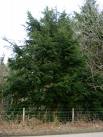Pacific Hemlock Tree Information
Images of Pacific Hemlock:






Pacific Hemlock grows in the following 8 states and provinces:
Alaska, Alberta, British Columbia, California, Idaho, Montana, Oregon, WashingtonInformation about Pacific Hemlock:
The Tsuga Heterophylla is commonly known as the Pacific Hemlock, West Coast Hemlock as well as Western Hemlock.
The currently accepted scientific name for western hemlock is Tsuga heterophylla (Raf.) Sarg. . There are no recognized subspecies, varieties, or forms. A natural hybrid between western hemlock and mountain hemlock (Tsuga mertensiana), Tsuga x jeffreyi (Henry) Henry, has been reported .Western hemlock occurs in the Coast Ranges from Sonoma County California to the Kenai Peninsula in Alaska. Inland it occurs along the western and upper eastern slopes of the Cascade Range in Oregon and Washington and west of the Continental Divide in the northern Rocky Mountains of Montana and Idaho, north to Prince George, British Columbia .Western hemlock commonly occurs as a dominant or codominant on low- to mid-elevation moist sites. In northern Idaho, plant communities dominated by western hemlock occupy the moist, moderate temperature sites within the maritime-influenced climatic zone of the northern Rocky Mountains. Here, western hemlock can be found as the climax dominant from 2,500 to 5,500 feet (760-1,680 m) and can dominate sites of all exposures and landforms except wet bottomlands where it is replaced or codominant with western redcedar (Thuja plicata) . In the Gifford Pinchot National Forest of Washington, the western-hemlock-dominated zone includes the lower elevation moist forests of the western Cascades . In Mount Rainier National Park, Washington, the western hemlock/devil's club (Oplopanax horridus) community occupies wet benches, terraces, and lower slopes at low elevations . The western hemlock riparian dominance type in Montana described by Hansen and others is an infrequent cover type restricted to northwestern Montana on toe-slope seepages, moist benches, and wet bottoms adjacent to streams. Published classifications identifying western hemlock as a dominant or codominant are as follows: Classification and management of riparian and wetland sites in northwest Montana . Classification of montane forest community types in the Cedar River drainage of western Washington, U.S.A. . The forest communities of Mount Rainier National Park . Forest habitat types of Montana . Forest habitat types of northern Idaho: A second approximation . Forest types of the North Cascades National Park Service complex . Forest vegetation of eastern Washington and northern Idaho . A guide to the interior cedar-hemlock zone, northwestern transitional subzone (ICHg), in the Prince Rupert Forest Region, British Columbia . Natural vegetation of Oregon and Washington . Plant association and management guide . Plant association and management guide for the western hemlock zone. Gifford Pinchot National Forest . Plant association and management guide for the western hemlock zone: Mt. Hood National Forest . Plant association and management guide. Willamette National Forest . A preliminary classification of forest communities in the central portion of the western Cascades in Oregon . Preliminary forest plant association management guide. Ketchikan area, Tongass National Forest . Preliminary forest plant associations of the Stikine area Tongass National Forest . Preliminary plant associations of the Siskiyou Mountain province . Preliminary plant associations of the southern Oregon Cascade Mountain Province . Reference material Daubenmire habitat types . Riparian dominance types of Montana . A study of the vegetation of southeastern Washington and adjacent Idaho . Vegetation mapping and community description of a small western cascade watershed . Vegetation of the Abbott Creek Research Natural Area, Oregon .Some of the information provided here is attributed to:Tesky, Julie L. 1992. Tsuga heterophylla. In: Fire Effects Information System, [Online]. U.S. Department of Agriculture, Forest Service, Rocky Mountain Research Station, Fire Sciences Laboratory (Producer). , available at the USDA Fire Effects Information System (FEIS) website